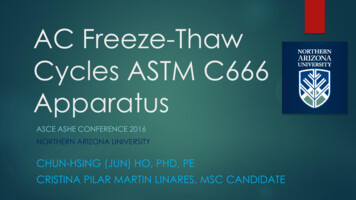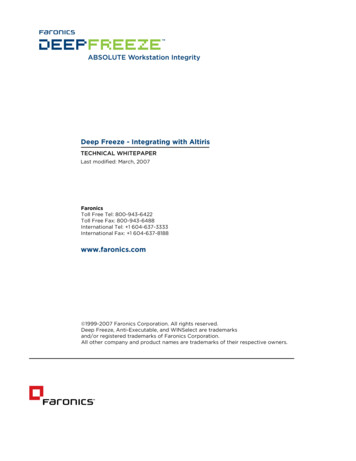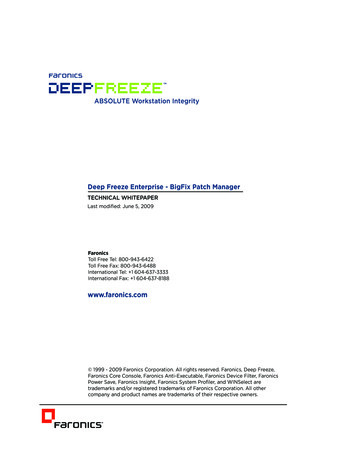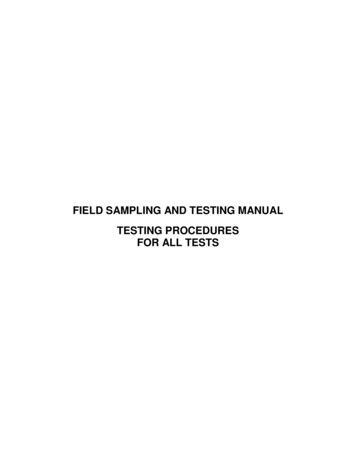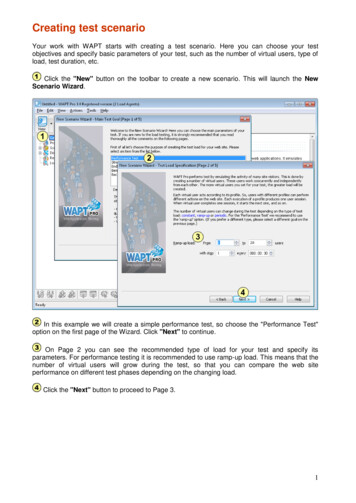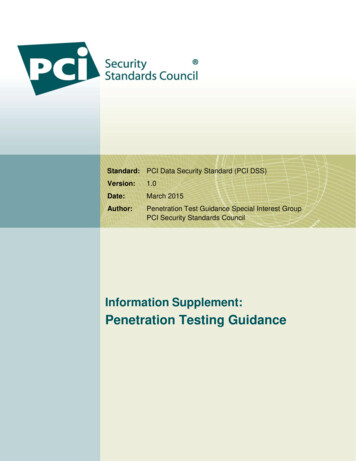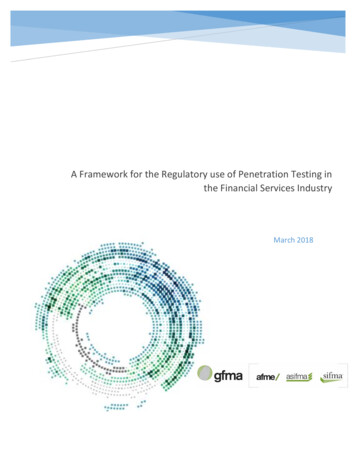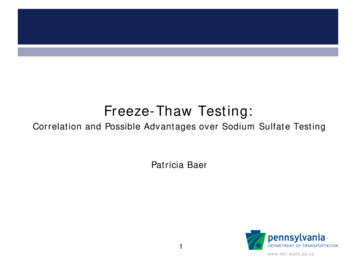
Transcription
Freeze-Thaw Testing:Correlation and Possible Advantages over Sodium Sulfate TestingPatricia Baer1www.dot.state.pa.us
History: Issues in District 12 on I-702www.dot.state.pa.us
History: I-70:Investigation by CTL Group– Subbase was a by-product aggregate:Degradation of the aggregateparticles was likely a combined result of high level of saturation, the chemical dissolutionprocess and the grinding of the particles against each other under dynamic traffic loading. Problems with Sodium sulfate– Recycled Concrete Aggregate (RCA):We do not perform sodiumsulfate testing on RCA because of the high amount of loss.– Weathered Slag aggregate:Due to the existing chemicals in the aggregate,we cannot get full saturation with a sodium sulfate solution in order to mimic freeze-thaw in aroadway situation.– More and more recycled products3www.dot.state.pa.us
History: Problems with Sodium Sulfate– PTM No. 510:(continued):Soundness of Aggregate by use of Sodium Sulfate Stainless steel containers Standard gradation is used for calculating Loss– AASHTO T 104:Soundness of Aggregate by Use of Sodium Sulfateor Magnesium Sulfate Sieves are used Actual gradation is used for calculating Loss Note 2 – Some aggregates containing carbonates or magnesium areattacked chemically by fresh sulfate solution, resulting in erroneously highmeasured losses.4www.dot.state.pa.us
History: Problems with Sodium Sulfate(continued):– AASHTO T 104:Soundness of Aggregate by Use of Sodium Sulfateor Magnesium Sulfate Precision Indexes– Multi-laboratory:» Coefficient of variation (1s) – 41%» Difference between two tests(d2s) – 116% (of average)– Single Operator:» Coefficient of variation (1s) – 24%» Difference between two tests(d2s) – 68% (of average)5www.dot.state.pa.us
Research: Due to our concerns with using a sodium sulfatesolution, we looked for other test methods tocheck the durability of all products that would beused for subbase. We investigated testing done by other DOT’s andother countries. We settle on a European test method. There wereestablished limits and they had experience withtesting by-products.6www.dot.state.pa.us
Research: Test method: DIN EN 1367-1 Determination ofresistance to freezing and thawing.– Similar to AASHTO T 103 (procedure A) Reduce sample – coarse fraction onlySoak sampleFreeze and thaw sample for 10 cyclesSample is washed prior to weighing back.Percent loss is the actual loss7www.dot.state.pa.us
Research: Road and Transportation Research Association– Technical Delivery Terms for Aggregates in RoadConstruction : TL Gestein-StB 04 The “TLGestein-StB” contains requirements placed onnatural, industrially manufactured and recycled aggregatesthat are used in the production of surfacings made ofbituminous mixtures, concrete hydraulically bound andunbound mixtures, cobble and slab paving, slurry surfacingand surface treatment.www.dot.state.pa.us
Research: TL Gestein-StB 04– 2.2.14.2 Resistance to Freeze-Thaw Attack If required, the resistance to freeze-that attack according oDIN EN 1367-1 may be determined. If must fulfil therequirements of one of the categories in Table 19.Table 19: Requirements for Resistance to Freeze-Thaw AttackFrost Resistance( loss in wt. %)CategoryF 1F1 2F2 4F4 4F(declared)9www.dot.state.pa.us
Research: TL Gestein-StB 04(continued):– 2.2.14 Freeze-Thaw Attack Proof of sufficient resistance to freeze-thaw attack is to beobtained indirectly by determining water absorption and, ifrequired, by subsequently determining the resistance tofreeze-thaw attack. The resistance to freeze-thaw attackmay also be determined directly.10www.dot.state.pa.us
Testing: Test results of high absorptive aggregate:Te11www.dot.state.pa.us
Special Provision: Currently using for subbase:In accordance with Section 350 and as follows:Revise Section 350.2(a) Aggregates. to read as follows:(a) Aggregate - Provide Type C or better, No. 2A material with freeze thawresistance according to European Standard DIN EN 13242 with a maximumfreeze/thaw loss of 2% as determined by European Standard DIN EN 1367-1for all slag aggregates and any natural aggregate whose absorption exceeds2%. Test for thermal and weathering properties of aggregates, Part 1 :Determination of resistance to freezing and thawing.12www.dot.state.pa.us
Testing: Continue testing and research– Equipment– Test method– Limits13www.dot.state.pa.us
Testing: Purchased new equipment14www.dot.state.pa.us
Research:SampleContainersAASHTO T-103 (Procedure A)flexible containers (plastic, rubber),sufficient size to hold samplesEN 1367-1sheet metal cans (seamless) 0.6mmthick, 2000mL capacity, id. 120mm 140mm, ih. 170mm - 220mmsieves (coarse)(1) 9.5mm - 4.75mm 300 5 g(1) 8mm - 4mm 1000 50g(2) 19.0mm - 9.5mm 1000 30 g12.5mm - 9.5mm 330 5 g19.0mm - 12.5mm 670 10 g(2) 16mm - 8mm 2000 100g(3) 37.5mm - 19.0mm 1500 50 g25.0mm - 19.0mm 500 30 g37.5mm - 25.0mm 1000 50 g(3) 32mm - 16mm 4000 200g(4) 63mm - 37.5mm 5000 300 g50mm - 37.5mm 2000 200 g63mm - 50mm 3000 300 g(4) 63mm - 32mm 6000 300gfine aggregateyesnosoaking24 4 hrs at 23 3 C24 hrs at 20 3 Cfreeze cycles23 3 C to -23 3 Chold for a minimum of 2 hrs20 3 C to 0 C in 2.5 0.5 hrshold for 3.5 0.5 hrs0 C to -17.5 2.5 C in 3 0.5 hrshold for a minimum of 4 hrsthaw cycles"-23 3 C to 21 3 C (in air)hold for a minimum of 0.5 hrs"-17.5 2.5 C to 20 3 C (in water)hold for a maximum of 10 hrsfreeze/thaw cycleshould not exceed 24 hrs25 cyclesshould not exceed 24 hrs10 cyclesafter completionof cyclesdry to constant mass, sieve, weighwash and sieve, dry to a constant massweighsieves fordetermining loss(1)(2)(3)(4)(1)(2)(3)(4)calculation of lossweighted against gradation of sample4.0mm8.0mm16.0mm31.5mm2mm4mm8mm16mmactual losswww.dot.state.pa.us
Testing: Testing of EN 1367 vs AASHTO T-10316www.dot.state.pa.us
Future: Continue testing subbase material and tweakspecification Started testing AASHTO #8 and #57 about a yearago Look at setting limits for AASHTO #8 and # 5717www.dot.state.pa.us
– AASHTO T 104: Soundness of Aggregate by Use of Sodium Sulfate or Magnesium Sulfate Sieves are used Actual gradation is used for calculating Loss Note 2 – Some aggregates containing carbonates or magnesium are attacked chemically by fresh sulfate solution, resulting in erroneously high - measured losses. 4
